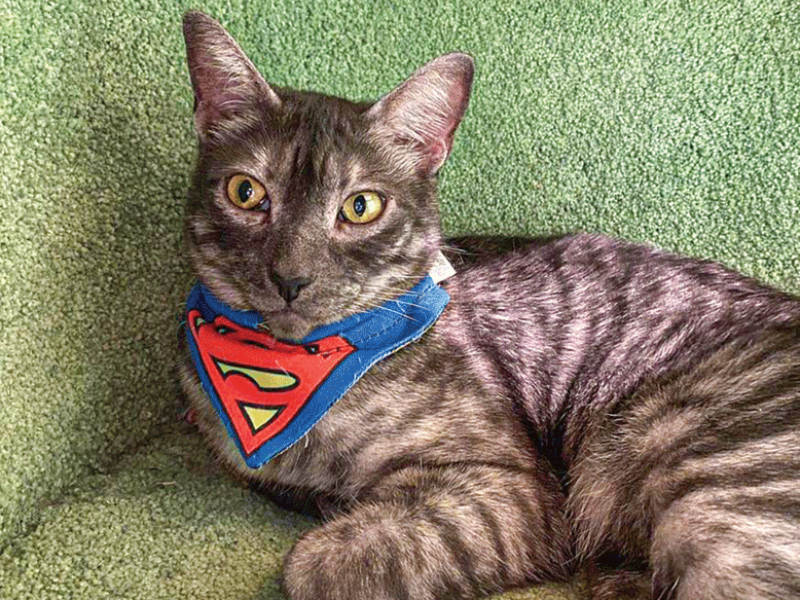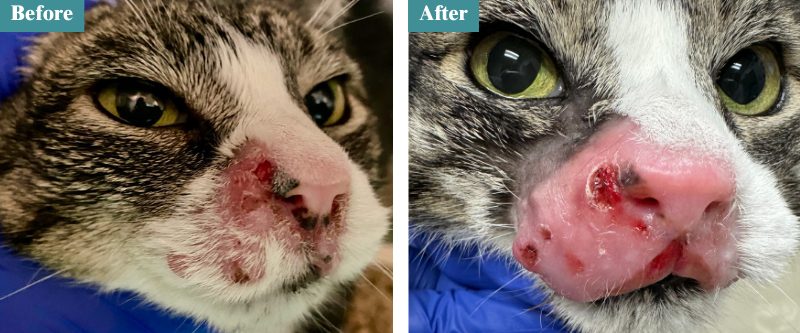
Treating cats with FIP
Clients with cats have been largely on their own when it comes to treating feline infectious peritonitis (FIP) because an experimental antiviral treatment—GS-441524—was available in the United States only on the black market. The nucleoside analogue works to prevent the virus from replicating and was found to be effective in a 2019 study.1 However, because it was not obtainable legally, veterinarians were unable to prescribe or recommend it.
That has changed. While the medication is still not approved by the U.S. Food and Drug Administration (FDA), a compounded oral formula from a partnership between Stokes Pharmacy and the Bova Group is now available nationwide by veterinary prescription.
In a statement on May 10, the FDA announced2 it would not enforce new animal drug approval requirements for products compounded from GS-441524 when prescribed by a veterinarian for a specific feline patient for treatment of FIP as long as the manufacturer follows the conditions set out in GFI256.3
The antiviral works quite well, says Vicki Thayer, DVM, DABVP, director emeritus at the EveryCat Health Foundation (EHF), University of California Davis, with a success rate ranging from 80 percent to more than 90 percent. “Sometimes there can be complications or comorbidities that seem to be overwhelming, but some of the sickest cats can come around,” Dr. Thayer says.
If treatment begins early, cats can respond quickly. Treatment takes a minimum of 12 weeks, with some cats requiring an additional two to four weeks or more to stabilize signs and prevent relapsing, followed by a 12-week observation period after treatment stops.
Thayer says supportive care needs include oral or subcutaneous fluids, appetite stimulants, vitamin B12 injections, which can also stimulate appetite, and probiotics for liver support. Maropitant citrate can help cats with nausea, and visceral pain relief is important. Hydration and taking in calories are key.
“Many of these cats are so sick, but once they start on the antiviral treatment, I’ve seen a number of cases and reports where they start eating, oftentimes within a few days.”
Monitoring weight is essential, as well. “If cats being treated gain weight and their dosage doesn’t increase, they ended up getting less and less antiviral drug,” Thayer says. “Those are the cats that can slip into relapses.” She recommends having owners record the cat’s weight weekly using a baby scale and says some FIP support groups provide access to an app that provides a recommended dosage based on the cat’s weight entered weekly by the owner.
FIP support groups on social media can be important adjuncts to veterinary care, Thayer says. Administrators and members can provide emotional support and supportive care tips that may be beyond the bandwidth of a veterinarian in a busy practice. She also advises reading the FIP diagnosis guidelines provided by American Association of Feline Practitioners (AAFP) and EHF. “That gives a lot of background on FIP. It may not always cover treatment,” Thayer says, “but it gives a better understanding of the disease.”
Treating pain with radiation
Radiation therapy is most commonly thought of as a treatment for cancer, but its first use in veterinary patients was at University of Pennsylvania,4 where horses with laminitis and other neoplastic and inflammatory diseases were treated with low-dose-rate brachytherapy to help manage pain. Radiation therapy for treating pain from inflammatory diseases, such as canine osteoarthritis (OA), has also been reported.3
A study published in 2022 in the Canadian Veterinary Journal5 evaluated use of a single dose of external beam radiation therapy for treatment of refractory canine OA.
Researchers wrote: “In addition to its ability to target DNA and damage neoplastic cells, low doses of ionizing radiation have also been shown to have therapeutic effects in benign non-neoplastic conditions such as OA due to its immunomodulating and anti-inflammatory properties.”
In cases of OA, eligible dogs or cats include those with visible evidence of OA on radiographs and clinical signs of pain or lameness no longer controlled by other treatments. External beam radiation therapy is administered under short general anesthesia, necessitating a CBC, serum biochemistry, urinalysis and in some cases thoracic radiographs beforehand, as well as radiographs of the affected joint to plan radiation treatment fields. Researchers noted that some animals may experience mild fatigue, gastrointestinal signs or a decrease in appetite following treatment, related to stress of hospitalization and anesthesia.
At the EHF symposium on feline pain at the North Carolina State University (NCSU) in April, Tracy Gieger, DVM, ACVIM, ACVR, spoke on the use of external beam radiation therapy to treat cats and dogs with bladder inflammation, orthopedic disease, chronic inflammatory enteropathy, inflammatory rhinitis and cancer-associated pain, to name just a few.
In her lecture, Dr. Gieger noted with bone pain, for example, radiation therapy may help to decrease osteolysis by inhibiting osteoclast activity. Inflammatory cytokines can be reduced by radiation. Finally, it can decrease inflammatory cells, especially lymphocytes.
One interesting use is for treatment of feline interstitial cystitis, an ongoing disease that is typically not curable.
At NCSU, approximately 20 cats with FIC have received one treatment of radiation after failing medical management. None of the cats have shown adverse effects from the radiation and most were able to eventually be weaned off oral medication (a popular goal among clients). Only two have had a relapse of clinical signs. Client education is critical in these cases, however, and environmental modifications6 should be continued for the lifetime of the cat, Gieger says.
Radiation therapy treatments are brief, conducted on an outpatient basis, relatively inexpensive, and in some cases can be repeated if necessary.
“For inflammatory diseases, we’re typically using a lower total dose of radiation and fewer treatments of radiation,” Gieger says. “That means a lower cost.”
Including workup, treatment for the cats with FIC ranges from $1,500 to $2,000. The total cost for multiple treatments for cats with orthopedic conditions, such as Scottish fold osteodysplasia, is approximately $4,000.
Treatments are not limited to NCSU. They can be done at any facility offering radiation after consultation with the radiation oncologist at that facility.
“We provide telemedicine consults for cat owners, as well as email or phone consults for veterinarians,” Gieger says. “Especially for cats, we’ll call the pet owner, talk about what’s been done and review their veterinarian’s records and imaging, talk about the treatment options for their cat and what the next steps would be in the logistics.”

Rise of urgent care
Urgent care veterinary clinics are a growth area, says Tony Johnson, DVM, DACVECC, medical director of Veterinary Information Network. The increase in the number of pets during the pandemic forced a decrease in the capacity of clinics to care for them. At emergency clinics, Dr. Johnson says, “We were seeing pets for things that a general-practice vet would normally handle. Just like in human medicine, there became a need for places that could treat pets who weren’t banged up enough to go to the ER but who couldn’t wait a month to see the vet. Urgent care is trying to fill that void.”
Another reason for the increase in urgent care clinics is the focus on wellness in general practices. Routine annual exams, vaccinations, dentals, and spay/neuter surgeries can mean little time to see sick pets on a same-day basis.
“Things that definitely need to be seen quickly so they don’t get worse are sometimes difficult to accommodate in even a well-run practice,” says Dana Varble, DVM, CAE, chief veterinary officer of the North American Veterinary Community.
Veterinary practices are utilizing urgent care clinics to help lighten their load, Dr. Varble says.
“They’re set up for those urgent issues that can then be followed up with the regular vet to get resolution or additional testing done. I think there are many general practices utilizing them to help keep their schedule normal and predictable and allow their vets to have some more work-life balance.”
Artificial intelligence (AI) applications are just as popular in veterinary medicine as in other fields. While it still requires human oversight, AI tools can help veterinarians increase efficiency in a number of ways, from generating records and recommendations to analyzing lab results and detecting abnormalities in medical images.
At the Cornell University College of Veterinary Medicine, AI-related resources, research, and technology include use of radiomics on ultrasound images to predict whether cats have inflammation of the small intestines or lymphoma; trends in multidrug resistance over populations; and developing data- and model-driven approaches for controlling infectious diseases.7
However, as useful as AI can be, it still takes human knowledge to look at results of CBC analyzers or imaging tools and ensure that the information they provide makes sense. Potential challenges include the risk of bias arising from skewed information or image quality, and cost, use, management, and accessibility of data.8
“I love the idea of us being able to go into a room, examine a patient, talk with an owner and have an AI tool running in the background generating recommendations and exam notes,” Dr. Varble says. “But it’s still going to be on the veterinarian to make sure their records are accurate.”
To help veterinarians avoid pitfalls, groups, such as the Veterinary Innovation Council and American College of Veterinary Radiology, are actively working to put together guidelines for good machine learning, Varble says. “I think there’s an opportunity there where we have to help veterinarians understand what the tools are doing and how to evaluate them.” However, most important is supporting and utilizing human intelligence already available: veterinary technicians.
“We need to make sure every practice has veterinary technicians that have the ability to make it a career,” Varble says. “They’re practicing at the top of their license; they’re making enough money to live a good life. These are gifted, intelligent, well-trained folks and we need to make sure we’re keeping those people. I think that’s our biggest opportunity at this time is to understand how we can utilize our teams to the best.”
Kim Campbell Thornton has been writing about dogs, cats, wildlife, and marine life since 1985, and is a recipient of multiple awards for her articles and books from the Cat Writers Association, Dog Writers Association of America, and American Society of Journalists and Authors.
References
- Pedersen NC, Perron M, Bannasch M, et al. Efficacy and safety of the nucleoside analog GS-441524 for treatment of cats with naturally occurring feline infectious peritonitis. Journal of Feline Medicine and Surgery. 2019;21(4):271-281. doi:10.1177/1098612X19825701
- https://www.fda.gov/animal-veterinary/cvm-updates/fda-announces-position-use-compounded-gs-441524-treat-fip
- https://www.fda.gov/media/132567/download?attachment
- Reid, CF. A guide to veterinary radiation therapy. KNA Press, 1975.
- Solis, DB, Mayer, MN. Low dose radiation therapy for the treatment of refractory canine osteoarthritis. Canadian Veterinary Journal. V.63(8); 2022 Aug.
- https://indoorpet.osu.edu/pet-owners.
- https://www.vet.cornell.edu/research/artificial-intelligence-veterinary-medicine
- Appleby, RB, Basran, PS. Artificial intelligence in veterinary medicine. Journal of the AVMA. Volume 260: Issue 8. 30 Mar 2022.
